Public Transportation Modes Comparison
VerifiedAdded on 2020/03/02
|9
|2819
|217
AI Summary
The assignment requires a comparative analysis of Light Rail Transit (LRT) and Bus Rapid Transit (BRT) systems. Students are expected to examine the advantages and disadvantages of each mode, considering factors like cost-effectiveness, environmental impact, ridership capacity, and influence on urban development. The assignment also delves into the impacts of LRT and BRT on travel behavior and city image, drawing upon research and case studies.
Contribute Materials
Your contribution can guide someone’s learning journey. Share your
documents today.
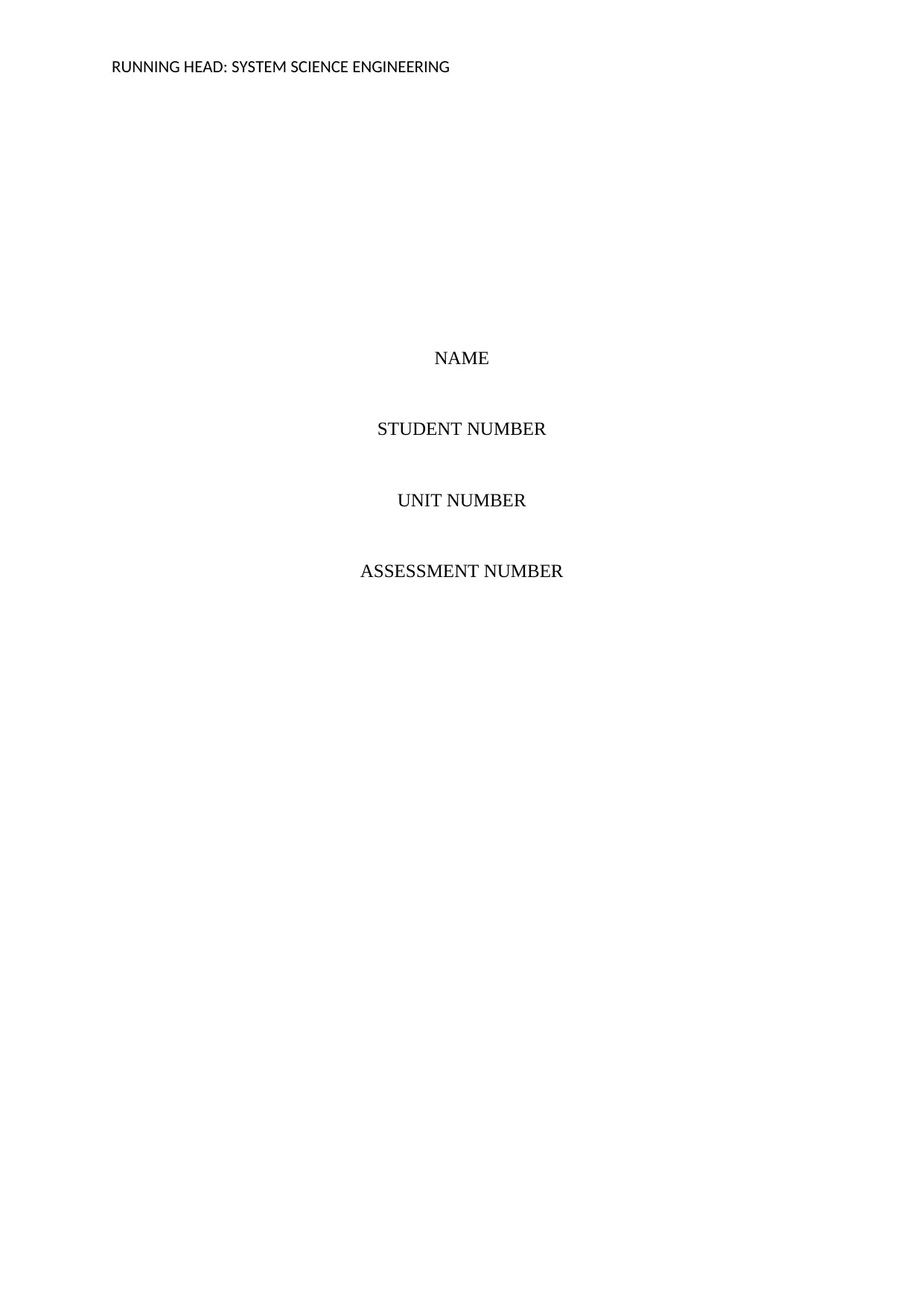
RUNNING HEAD: SYSTEM SCIENCE ENGINEERING
NAME
STUDENT NUMBER
UNIT NUMBER
ASSESSMENT NUMBER
NAME
STUDENT NUMBER
UNIT NUMBER
ASSESSMENT NUMBER
Secure Best Marks with AI Grader
Need help grading? Try our AI Grader for instant feedback on your assignments.

EXECUTIVE SUMMARY
With the increase in population densities in major cities, it is important to consider a transport system
where large volumes of people are moved periodically. This would reduce congestion, environmental
degradation and land utilization while providing high utility levels. It would also reduce costs for
riders who are included in the service area. This report analyses the two main modes of mass rapid
transportation and it is evident that light rail transport is preferred over bus rapid transport. It however
has it challenges, among which include high operation costs and high initial capital investment.
i
With the increase in population densities in major cities, it is important to consider a transport system
where large volumes of people are moved periodically. This would reduce congestion, environmental
degradation and land utilization while providing high utility levels. It would also reduce costs for
riders who are included in the service area. This report analyses the two main modes of mass rapid
transportation and it is evident that light rail transport is preferred over bus rapid transport. It however
has it challenges, among which include high operation costs and high initial capital investment.
i

RUNNING HEAD: SYSTEM SCIENCE ENGINEERING
TABLE OF CONTENTS:
EXECUTIVE SUMMARY......................................................................................................................i
INTRODUCTION...................................................................................................................................1
NEEDS DEFINITION.............................................................................................................................1
CONCEPTUAL ANALYSIS..................................................................................................................1
FUNCTIONAL ANALYSIS...................................................................................................................3
TRADEOFF ANALYSIS:.......................................................................................................................4
CONCLUSION........................................................................................................................................5
RECOMMENDATION...........................................................................................................................5
TABLE OF CONTENTS:
EXECUTIVE SUMMARY......................................................................................................................i
INTRODUCTION...................................................................................................................................1
NEEDS DEFINITION.............................................................................................................................1
CONCEPTUAL ANALYSIS..................................................................................................................1
FUNCTIONAL ANALYSIS...................................................................................................................3
TRADEOFF ANALYSIS:.......................................................................................................................4
CONCLUSION........................................................................................................................................5
RECOMMENDATION...........................................................................................................................5
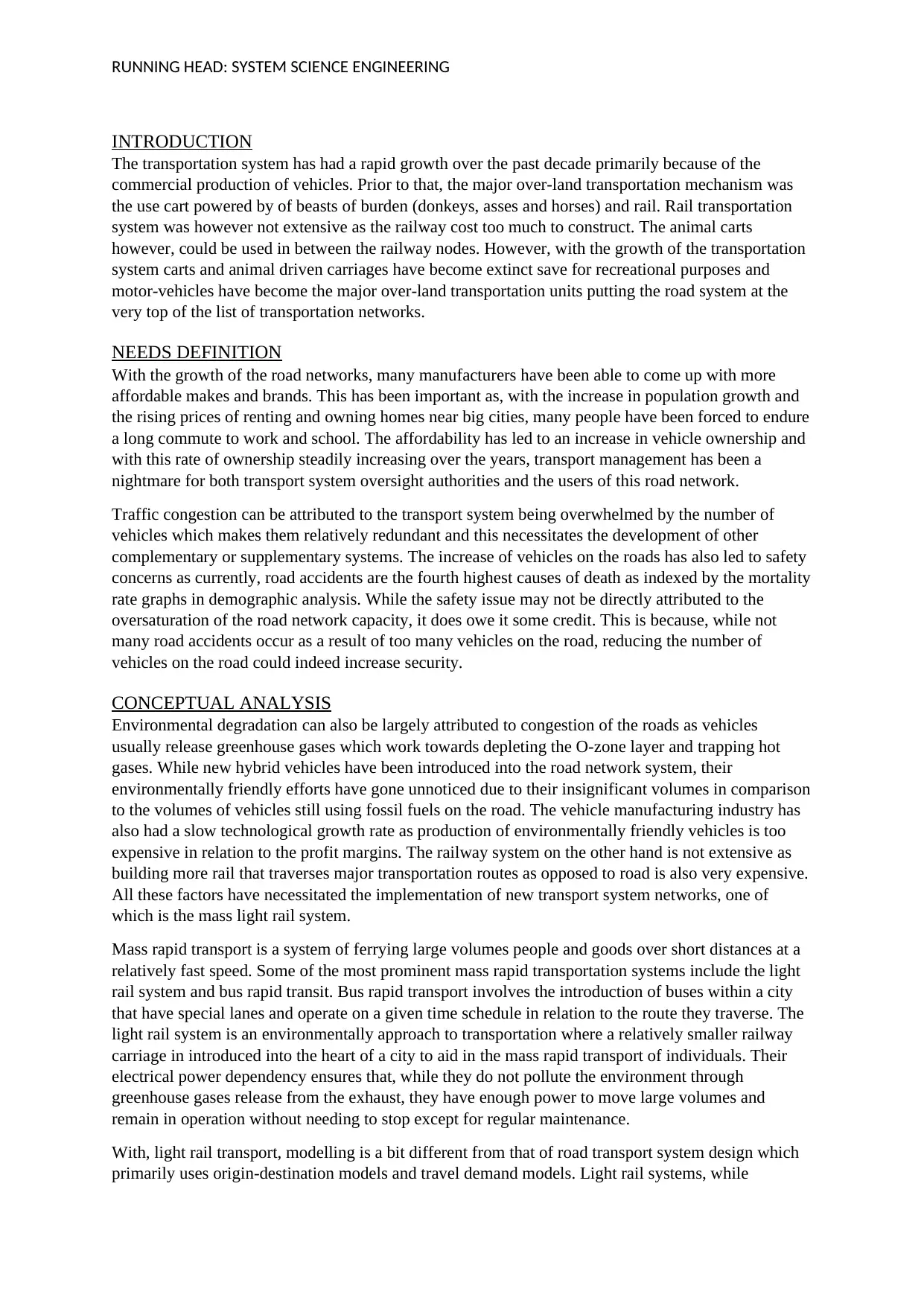
RUNNING HEAD: SYSTEM SCIENCE ENGINEERING
INTRODUCTION
The transportation system has had a rapid growth over the past decade primarily because of the
commercial production of vehicles. Prior to that, the major over-land transportation mechanism was
the use cart powered by of beasts of burden (donkeys, asses and horses) and rail. Rail transportation
system was however not extensive as the railway cost too much to construct. The animal carts
however, could be used in between the railway nodes. However, with the growth of the transportation
system carts and animal driven carriages have become extinct save for recreational purposes and
motor-vehicles have become the major over-land transportation units putting the road system at the
very top of the list of transportation networks.
NEEDS DEFINITION
With the growth of the road networks, many manufacturers have been able to come up with more
affordable makes and brands. This has been important as, with the increase in population growth and
the rising prices of renting and owning homes near big cities, many people have been forced to endure
a long commute to work and school. The affordability has led to an increase in vehicle ownership and
with this rate of ownership steadily increasing over the years, transport management has been a
nightmare for both transport system oversight authorities and the users of this road network.
Traffic congestion can be attributed to the transport system being overwhelmed by the number of
vehicles which makes them relatively redundant and this necessitates the development of other
complementary or supplementary systems. The increase of vehicles on the roads has also led to safety
concerns as currently, road accidents are the fourth highest causes of death as indexed by the mortality
rate graphs in demographic analysis. While the safety issue may not be directly attributed to the
oversaturation of the road network capacity, it does owe it some credit. This is because, while not
many road accidents occur as a result of too many vehicles on the road, reducing the number of
vehicles on the road could indeed increase security.
CONCEPTUAL ANALYSIS
Environmental degradation can also be largely attributed to congestion of the roads as vehicles
usually release greenhouse gases which work towards depleting the O-zone layer and trapping hot
gases. While new hybrid vehicles have been introduced into the road network system, their
environmentally friendly efforts have gone unnoticed due to their insignificant volumes in comparison
to the volumes of vehicles still using fossil fuels on the road. The vehicle manufacturing industry has
also had a slow technological growth rate as production of environmentally friendly vehicles is too
expensive in relation to the profit margins. The railway system on the other hand is not extensive as
building more rail that traverses major transportation routes as opposed to road is also very expensive.
All these factors have necessitated the implementation of new transport system networks, one of
which is the mass light rail system.
Mass rapid transport is a system of ferrying large volumes people and goods over short distances at a
relatively fast speed. Some of the most prominent mass rapid transportation systems include the light
rail system and bus rapid transit. Bus rapid transport involves the introduction of buses within a city
that have special lanes and operate on a given time schedule in relation to the route they traverse. The
light rail system is an environmentally approach to transportation where a relatively smaller railway
carriage in introduced into the heart of a city to aid in the mass rapid transport of individuals. Their
electrical power dependency ensures that, while they do not pollute the environment through
greenhouse gases release from the exhaust, they have enough power to move large volumes and
remain in operation without needing to stop except for regular maintenance.
With, light rail transport, modelling is a bit different from that of road transport system design which
primarily uses origin-destination models and travel demand models. Light rail systems, while
INTRODUCTION
The transportation system has had a rapid growth over the past decade primarily because of the
commercial production of vehicles. Prior to that, the major over-land transportation mechanism was
the use cart powered by of beasts of burden (donkeys, asses and horses) and rail. Rail transportation
system was however not extensive as the railway cost too much to construct. The animal carts
however, could be used in between the railway nodes. However, with the growth of the transportation
system carts and animal driven carriages have become extinct save for recreational purposes and
motor-vehicles have become the major over-land transportation units putting the road system at the
very top of the list of transportation networks.
NEEDS DEFINITION
With the growth of the road networks, many manufacturers have been able to come up with more
affordable makes and brands. This has been important as, with the increase in population growth and
the rising prices of renting and owning homes near big cities, many people have been forced to endure
a long commute to work and school. The affordability has led to an increase in vehicle ownership and
with this rate of ownership steadily increasing over the years, transport management has been a
nightmare for both transport system oversight authorities and the users of this road network.
Traffic congestion can be attributed to the transport system being overwhelmed by the number of
vehicles which makes them relatively redundant and this necessitates the development of other
complementary or supplementary systems. The increase of vehicles on the roads has also led to safety
concerns as currently, road accidents are the fourth highest causes of death as indexed by the mortality
rate graphs in demographic analysis. While the safety issue may not be directly attributed to the
oversaturation of the road network capacity, it does owe it some credit. This is because, while not
many road accidents occur as a result of too many vehicles on the road, reducing the number of
vehicles on the road could indeed increase security.
CONCEPTUAL ANALYSIS
Environmental degradation can also be largely attributed to congestion of the roads as vehicles
usually release greenhouse gases which work towards depleting the O-zone layer and trapping hot
gases. While new hybrid vehicles have been introduced into the road network system, their
environmentally friendly efforts have gone unnoticed due to their insignificant volumes in comparison
to the volumes of vehicles still using fossil fuels on the road. The vehicle manufacturing industry has
also had a slow technological growth rate as production of environmentally friendly vehicles is too
expensive in relation to the profit margins. The railway system on the other hand is not extensive as
building more rail that traverses major transportation routes as opposed to road is also very expensive.
All these factors have necessitated the implementation of new transport system networks, one of
which is the mass light rail system.
Mass rapid transport is a system of ferrying large volumes people and goods over short distances at a
relatively fast speed. Some of the most prominent mass rapid transportation systems include the light
rail system and bus rapid transit. Bus rapid transport involves the introduction of buses within a city
that have special lanes and operate on a given time schedule in relation to the route they traverse. The
light rail system is an environmentally approach to transportation where a relatively smaller railway
carriage in introduced into the heart of a city to aid in the mass rapid transport of individuals. Their
electrical power dependency ensures that, while they do not pollute the environment through
greenhouse gases release from the exhaust, they have enough power to move large volumes and
remain in operation without needing to stop except for regular maintenance.
With, light rail transport, modelling is a bit different from that of road transport system design which
primarily uses origin-destination models and travel demand models. Light rail systems, while
Secure Best Marks with AI Grader
Need help grading? Try our AI Grader for instant feedback on your assignments.
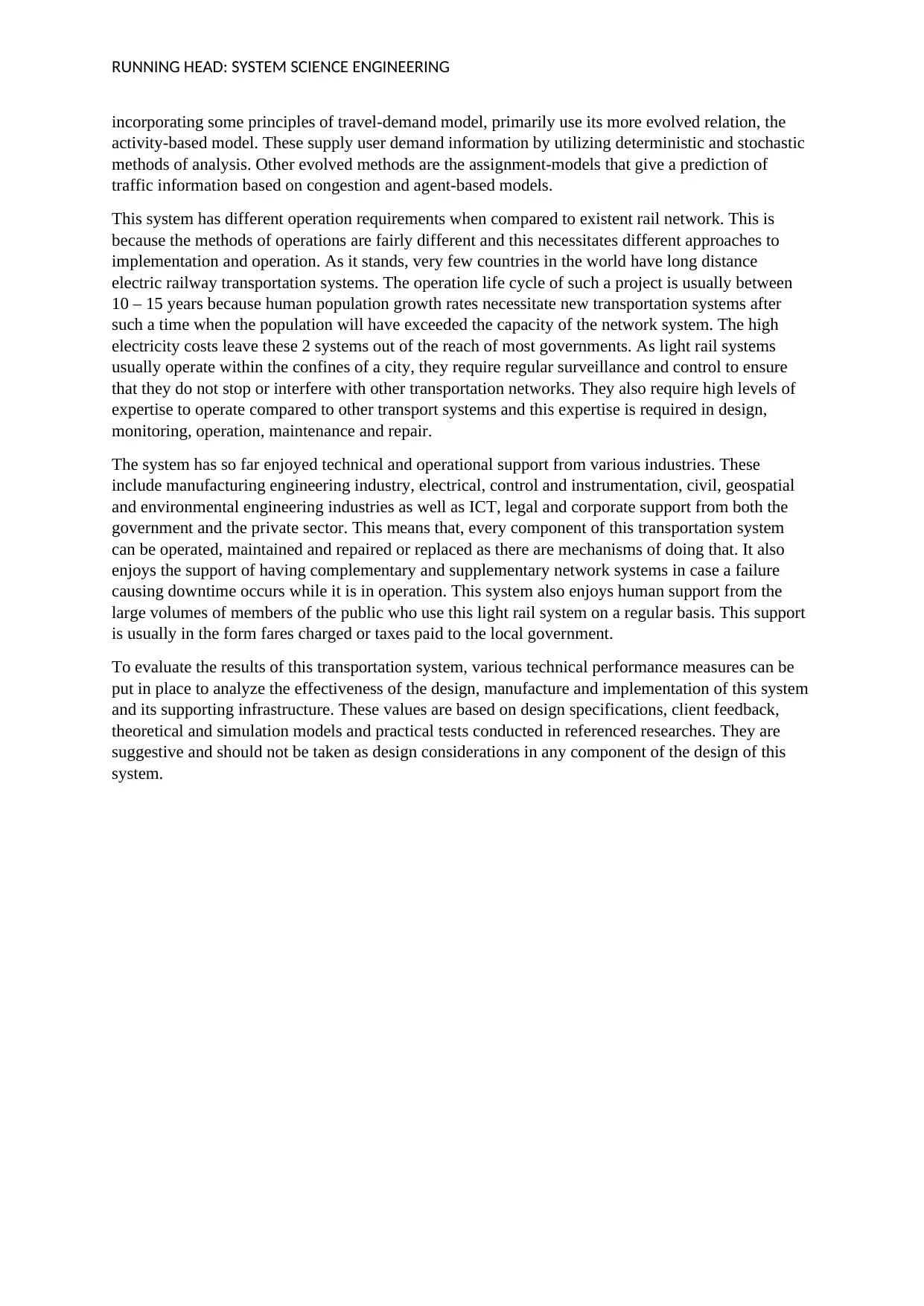
RUNNING HEAD: SYSTEM SCIENCE ENGINEERING
incorporating some principles of travel-demand model, primarily use its more evolved relation, the
activity-based model. These supply user demand information by utilizing deterministic and stochastic
methods of analysis. Other evolved methods are the assignment-models that give a prediction of
traffic information based on congestion and agent-based models.
This system has different operation requirements when compared to existent rail network. This is
because the methods of operations are fairly different and this necessitates different approaches to
implementation and operation. As it stands, very few countries in the world have long distance
electric railway transportation systems. The operation life cycle of such a project is usually between
10 – 15 years because human population growth rates necessitate new transportation systems after
such a time when the population will have exceeded the capacity of the network system. The high
electricity costs leave these 2 systems out of the reach of most governments. As light rail systems
usually operate within the confines of a city, they require regular surveillance and control to ensure
that they do not stop or interfere with other transportation networks. They also require high levels of
expertise to operate compared to other transport systems and this expertise is required in design,
monitoring, operation, maintenance and repair.
The system has so far enjoyed technical and operational support from various industries. These
include manufacturing engineering industry, electrical, control and instrumentation, civil, geospatial
and environmental engineering industries as well as ICT, legal and corporate support from both the
government and the private sector. This means that, every component of this transportation system
can be operated, maintained and repaired or replaced as there are mechanisms of doing that. It also
enjoys the support of having complementary and supplementary network systems in case a failure
causing downtime occurs while it is in operation. This system also enjoys human support from the
large volumes of members of the public who use this light rail system on a regular basis. This support
is usually in the form fares charged or taxes paid to the local government.
To evaluate the results of this transportation system, various technical performance measures can be
put in place to analyze the effectiveness of the design, manufacture and implementation of this system
and its supporting infrastructure. These values are based on design specifications, client feedback,
theoretical and simulation models and practical tests conducted in referenced researches. They are
suggestive and should not be taken as design considerations in any component of the design of this
system.
incorporating some principles of travel-demand model, primarily use its more evolved relation, the
activity-based model. These supply user demand information by utilizing deterministic and stochastic
methods of analysis. Other evolved methods are the assignment-models that give a prediction of
traffic information based on congestion and agent-based models.
This system has different operation requirements when compared to existent rail network. This is
because the methods of operations are fairly different and this necessitates different approaches to
implementation and operation. As it stands, very few countries in the world have long distance
electric railway transportation systems. The operation life cycle of such a project is usually between
10 – 15 years because human population growth rates necessitate new transportation systems after
such a time when the population will have exceeded the capacity of the network system. The high
electricity costs leave these 2 systems out of the reach of most governments. As light rail systems
usually operate within the confines of a city, they require regular surveillance and control to ensure
that they do not stop or interfere with other transportation networks. They also require high levels of
expertise to operate compared to other transport systems and this expertise is required in design,
monitoring, operation, maintenance and repair.
The system has so far enjoyed technical and operational support from various industries. These
include manufacturing engineering industry, electrical, control and instrumentation, civil, geospatial
and environmental engineering industries as well as ICT, legal and corporate support from both the
government and the private sector. This means that, every component of this transportation system
can be operated, maintained and repaired or replaced as there are mechanisms of doing that. It also
enjoys the support of having complementary and supplementary network systems in case a failure
causing downtime occurs while it is in operation. This system also enjoys human support from the
large volumes of members of the public who use this light rail system on a regular basis. This support
is usually in the form fares charged or taxes paid to the local government.
To evaluate the results of this transportation system, various technical performance measures can be
put in place to analyze the effectiveness of the design, manufacture and implementation of this system
and its supporting infrastructure. These values are based on design specifications, client feedback,
theoretical and simulation models and practical tests conducted in referenced researches. They are
suggestive and should not be taken as design considerations in any component of the design of this
system.
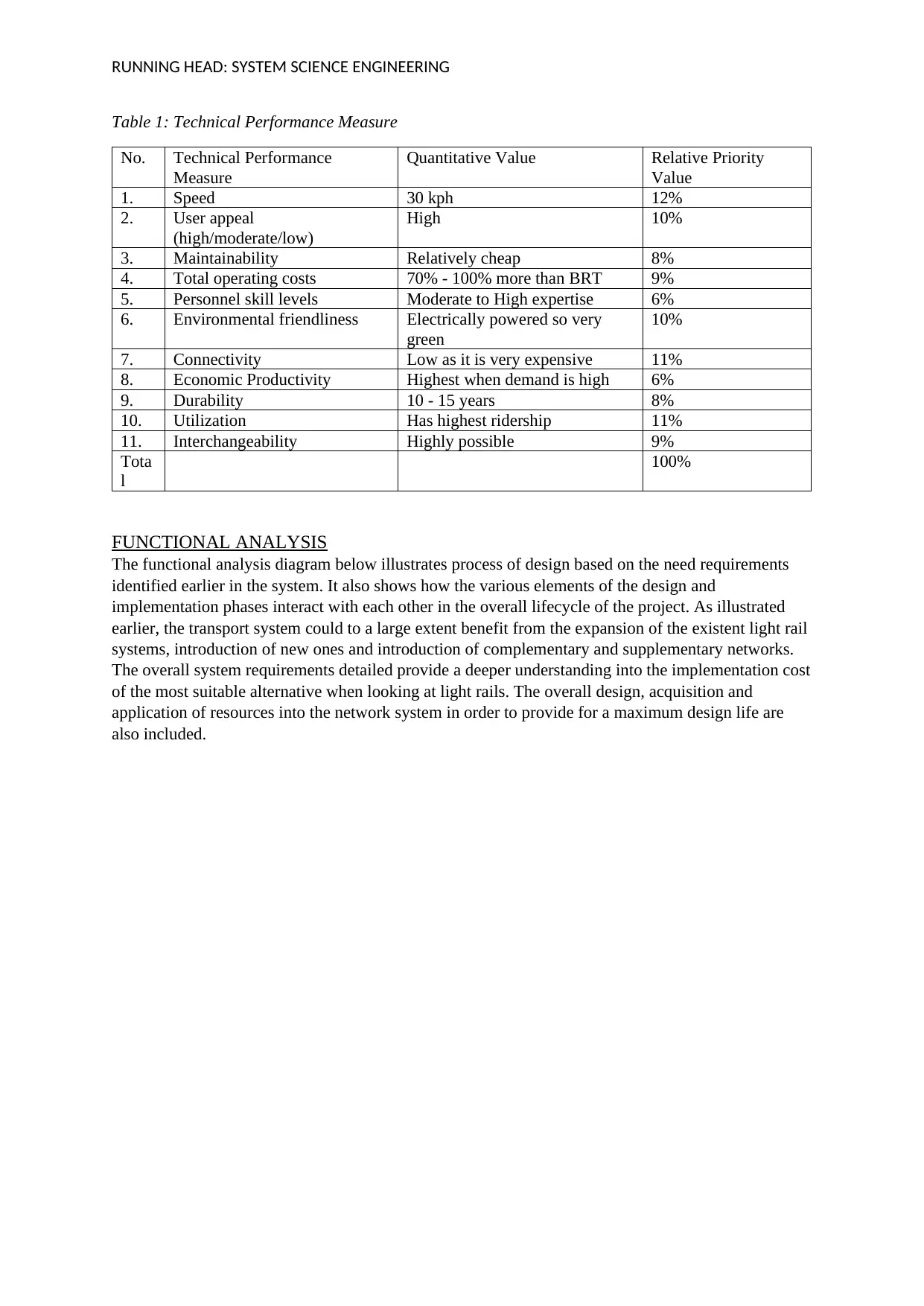
RUNNING HEAD: SYSTEM SCIENCE ENGINEERING
Table 1: Technical Performance Measure
No. Technical Performance
Measure
Quantitative Value Relative Priority
Value
1. Speed 30 kph 12%
2. User appeal
(high/moderate/low)
High 10%
3. Maintainability Relatively cheap 8%
4. Total operating costs 70% - 100% more than BRT 9%
5. Personnel skill levels Moderate to High expertise 6%
6. Environmental friendliness Electrically powered so very
green
10%
7. Connectivity Low as it is very expensive 11%
8. Economic Productivity Highest when demand is high 6%
9. Durability 10 - 15 years 8%
10. Utilization Has highest ridership 11%
11. Interchangeability Highly possible 9%
Tota
l
100%
FUNCTIONAL ANALYSIS
The functional analysis diagram below illustrates process of design based on the need requirements
identified earlier in the system. It also shows how the various elements of the design and
implementation phases interact with each other in the overall lifecycle of the project. As illustrated
earlier, the transport system could to a large extent benefit from the expansion of the existent light rail
systems, introduction of new ones and introduction of complementary and supplementary networks.
The overall system requirements detailed provide a deeper understanding into the implementation cost
of the most suitable alternative when looking at light rails. The overall design, acquisition and
application of resources into the network system in order to provide for a maximum design life are
also included.
Table 1: Technical Performance Measure
No. Technical Performance
Measure
Quantitative Value Relative Priority
Value
1. Speed 30 kph 12%
2. User appeal
(high/moderate/low)
High 10%
3. Maintainability Relatively cheap 8%
4. Total operating costs 70% - 100% more than BRT 9%
5. Personnel skill levels Moderate to High expertise 6%
6. Environmental friendliness Electrically powered so very
green
10%
7. Connectivity Low as it is very expensive 11%
8. Economic Productivity Highest when demand is high 6%
9. Durability 10 - 15 years 8%
10. Utilization Has highest ridership 11%
11. Interchangeability Highly possible 9%
Tota
l
100%
FUNCTIONAL ANALYSIS
The functional analysis diagram below illustrates process of design based on the need requirements
identified earlier in the system. It also shows how the various elements of the design and
implementation phases interact with each other in the overall lifecycle of the project. As illustrated
earlier, the transport system could to a large extent benefit from the expansion of the existent light rail
systems, introduction of new ones and introduction of complementary and supplementary networks.
The overall system requirements detailed provide a deeper understanding into the implementation cost
of the most suitable alternative when looking at light rails. The overall design, acquisition and
application of resources into the network system in order to provide for a maximum design life are
also included.
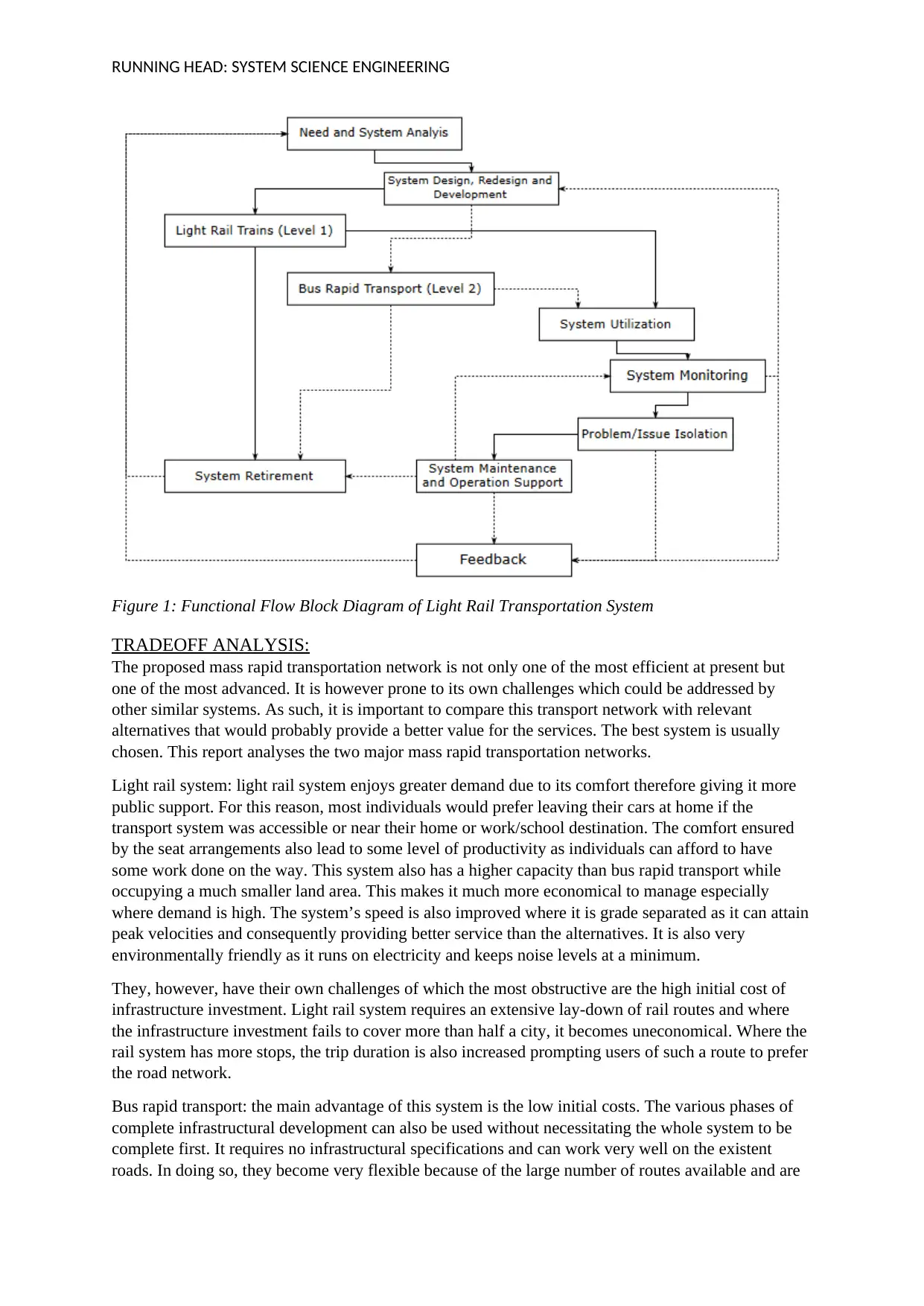
RUNNING HEAD: SYSTEM SCIENCE ENGINEERING
Figure 1: Functional Flow Block Diagram of Light Rail Transportation System
TRADEOFF ANALYSIS:
The proposed mass rapid transportation network is not only one of the most efficient at present but
one of the most advanced. It is however prone to its own challenges which could be addressed by
other similar systems. As such, it is important to compare this transport network with relevant
alternatives that would probably provide a better value for the services. The best system is usually
chosen. This report analyses the two major mass rapid transportation networks.
Light rail system: light rail system enjoys greater demand due to its comfort therefore giving it more
public support. For this reason, most individuals would prefer leaving their cars at home if the
transport system was accessible or near their home or work/school destination. The comfort ensured
by the seat arrangements also lead to some level of productivity as individuals can afford to have
some work done on the way. This system also has a higher capacity than bus rapid transport while
occupying a much smaller land area. This makes it much more economical to manage especially
where demand is high. The system’s speed is also improved where it is grade separated as it can attain
peak velocities and consequently providing better service than the alternatives. It is also very
environmentally friendly as it runs on electricity and keeps noise levels at a minimum.
They, however, have their own challenges of which the most obstructive are the high initial cost of
infrastructure investment. Light rail system requires an extensive lay-down of rail routes and where
the infrastructure investment fails to cover more than half a city, it becomes uneconomical. Where the
rail system has more stops, the trip duration is also increased prompting users of such a route to prefer
the road network.
Bus rapid transport: the main advantage of this system is the low initial costs. The various phases of
complete infrastructural development can also be used without necessitating the whole system to be
complete first. It requires no infrastructural specifications and can work very well on the existent
roads. In doing so, they become very flexible because of the large number of routes available and are
Figure 1: Functional Flow Block Diagram of Light Rail Transportation System
TRADEOFF ANALYSIS:
The proposed mass rapid transportation network is not only one of the most efficient at present but
one of the most advanced. It is however prone to its own challenges which could be addressed by
other similar systems. As such, it is important to compare this transport network with relevant
alternatives that would probably provide a better value for the services. The best system is usually
chosen. This report analyses the two major mass rapid transportation networks.
Light rail system: light rail system enjoys greater demand due to its comfort therefore giving it more
public support. For this reason, most individuals would prefer leaving their cars at home if the
transport system was accessible or near their home or work/school destination. The comfort ensured
by the seat arrangements also lead to some level of productivity as individuals can afford to have
some work done on the way. This system also has a higher capacity than bus rapid transport while
occupying a much smaller land area. This makes it much more economical to manage especially
where demand is high. The system’s speed is also improved where it is grade separated as it can attain
peak velocities and consequently providing better service than the alternatives. It is also very
environmentally friendly as it runs on electricity and keeps noise levels at a minimum.
They, however, have their own challenges of which the most obstructive are the high initial cost of
infrastructure investment. Light rail system requires an extensive lay-down of rail routes and where
the infrastructure investment fails to cover more than half a city, it becomes uneconomical. Where the
rail system has more stops, the trip duration is also increased prompting users of such a route to prefer
the road network.
Bus rapid transport: the main advantage of this system is the low initial costs. The various phases of
complete infrastructural development can also be used without necessitating the whole system to be
complete first. It requires no infrastructural specifications and can work very well on the existent
roads. In doing so, they become very flexible because of the large number of routes available and are
Paraphrase This Document
Need a fresh take? Get an instant paraphrase of this document with our AI Paraphraser
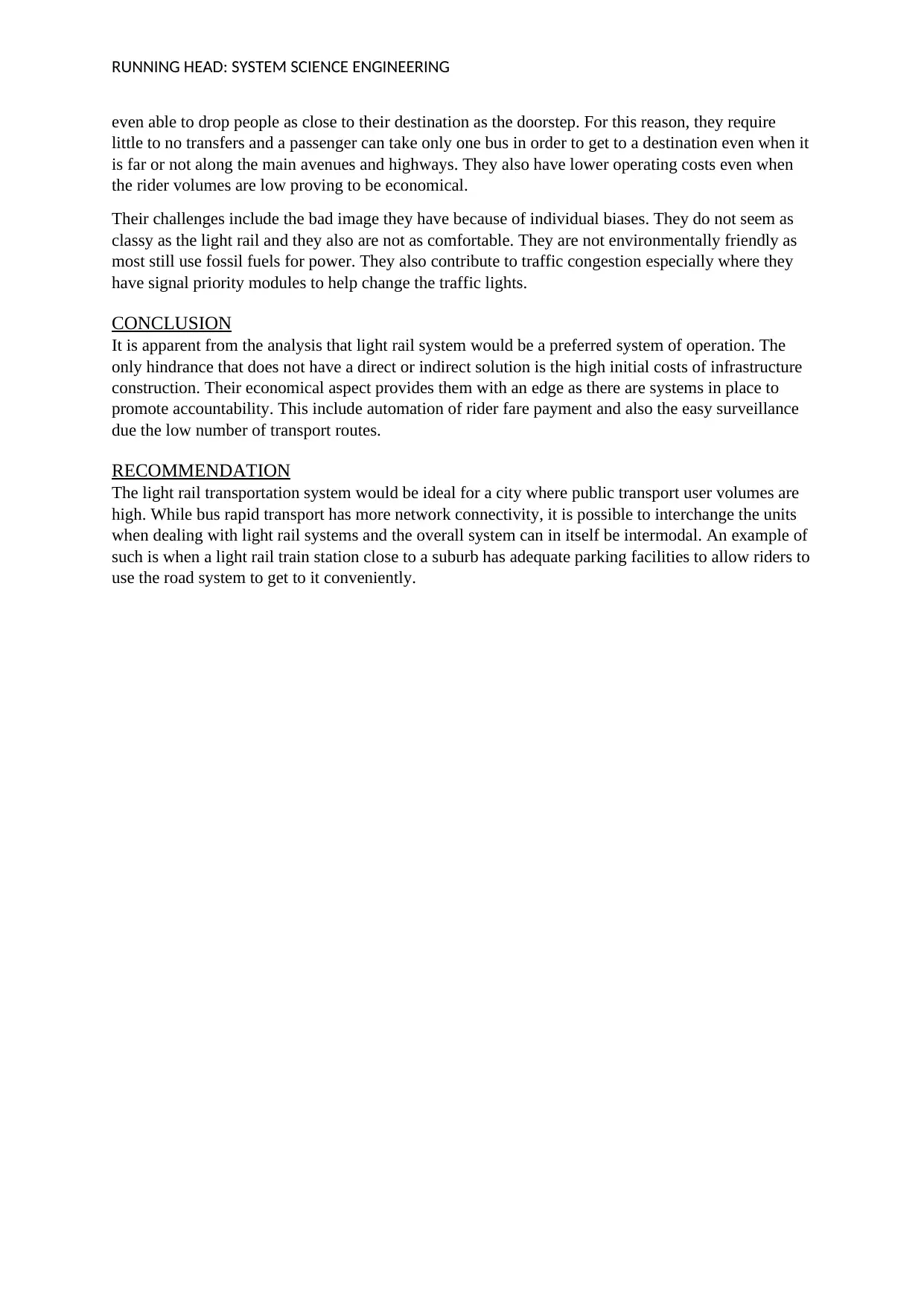
RUNNING HEAD: SYSTEM SCIENCE ENGINEERING
even able to drop people as close to their destination as the doorstep. For this reason, they require
little to no transfers and a passenger can take only one bus in order to get to a destination even when it
is far or not along the main avenues and highways. They also have lower operating costs even when
the rider volumes are low proving to be economical.
Their challenges include the bad image they have because of individual biases. They do not seem as
classy as the light rail and they also are not as comfortable. They are not environmentally friendly as
most still use fossil fuels for power. They also contribute to traffic congestion especially where they
have signal priority modules to help change the traffic lights.
CONCLUSION
It is apparent from the analysis that light rail system would be a preferred system of operation. The
only hindrance that does not have a direct or indirect solution is the high initial costs of infrastructure
construction. Their economical aspect provides them with an edge as there are systems in place to
promote accountability. This include automation of rider fare payment and also the easy surveillance
due the low number of transport routes.
RECOMMENDATION
The light rail transportation system would be ideal for a city where public transport user volumes are
high. While bus rapid transport has more network connectivity, it is possible to interchange the units
when dealing with light rail systems and the overall system can in itself be intermodal. An example of
such is when a light rail train station close to a suburb has adequate parking facilities to allow riders to
use the road system to get to it conveniently.
even able to drop people as close to their destination as the doorstep. For this reason, they require
little to no transfers and a passenger can take only one bus in order to get to a destination even when it
is far or not along the main avenues and highways. They also have lower operating costs even when
the rider volumes are low proving to be economical.
Their challenges include the bad image they have because of individual biases. They do not seem as
classy as the light rail and they also are not as comfortable. They are not environmentally friendly as
most still use fossil fuels for power. They also contribute to traffic congestion especially where they
have signal priority modules to help change the traffic lights.
CONCLUSION
It is apparent from the analysis that light rail system would be a preferred system of operation. The
only hindrance that does not have a direct or indirect solution is the high initial costs of infrastructure
construction. Their economical aspect provides them with an edge as there are systems in place to
promote accountability. This include automation of rider fare payment and also the easy surveillance
due the low number of transport routes.
RECOMMENDATION
The light rail transportation system would be ideal for a city where public transport user volumes are
high. While bus rapid transport has more network connectivity, it is possible to interchange the units
when dealing with light rail systems and the overall system can in itself be intermodal. An example of
such is when a light rail train station close to a suburb has adequate parking facilities to allow riders to
use the road system to get to it conveniently.
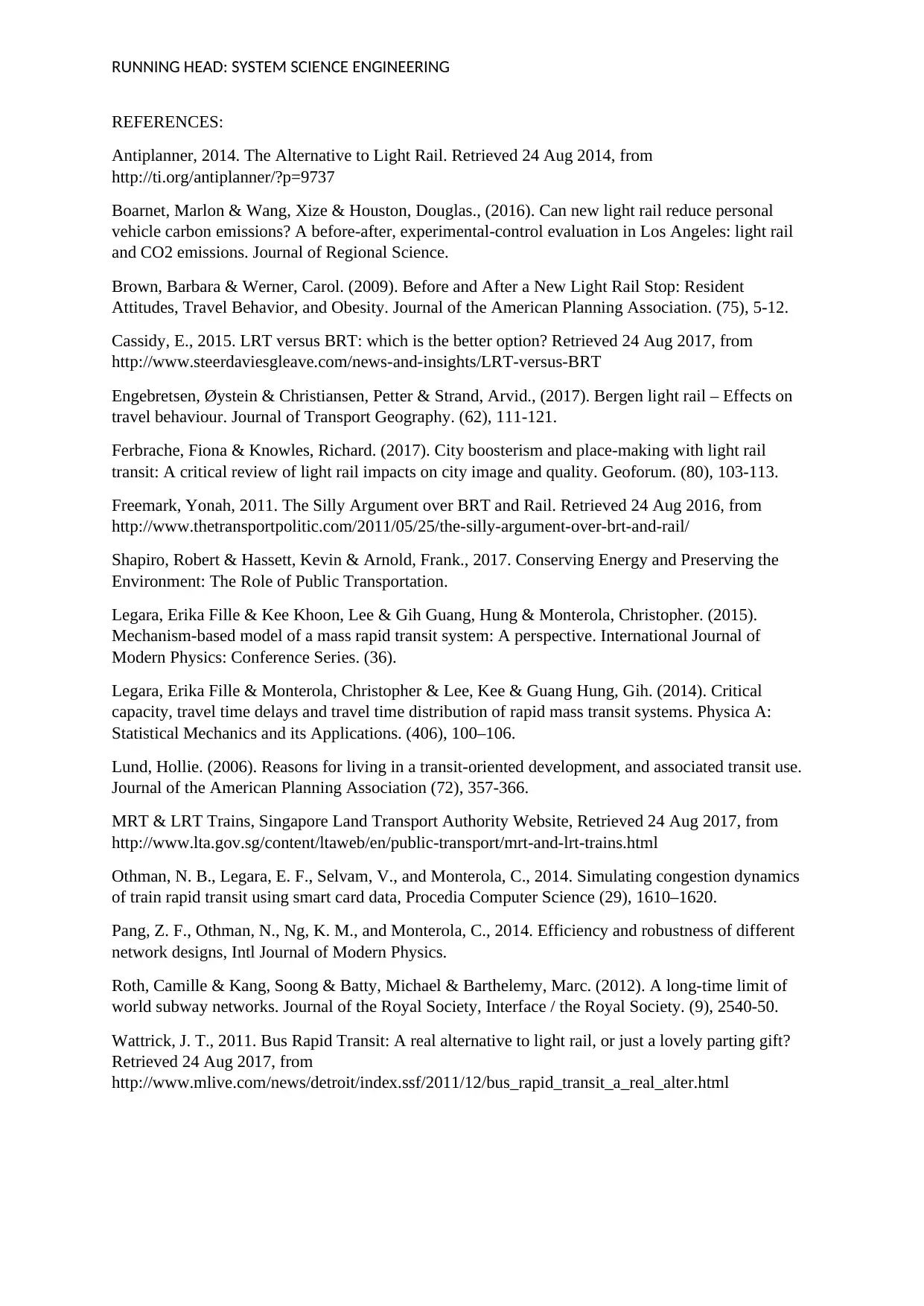
RUNNING HEAD: SYSTEM SCIENCE ENGINEERING
REFERENCES:
Antiplanner, 2014. The Alternative to Light Rail. Retrieved 24 Aug 2014, from
http://ti.org/antiplanner/?p=9737
Boarnet, Marlon & Wang, Xize & Houston, Douglas., (2016). Can new light rail reduce personal
vehicle carbon emissions? A before-after, experimental-control evaluation in Los Angeles: light rail
and CO2 emissions. Journal of Regional Science.
Brown, Barbara & Werner, Carol. (2009). Before and After a New Light Rail Stop: Resident
Attitudes, Travel Behavior, and Obesity. Journal of the American Planning Association. (75), 5-12.
Cassidy, E., 2015. LRT versus BRT: which is the better option? Retrieved 24 Aug 2017, from
http://www.steerdaviesgleave.com/news-and-insights/LRT-versus-BRT
Engebretsen, Øystein & Christiansen, Petter & Strand, Arvid., (2017). Bergen light rail – Effects on
travel behaviour. Journal of Transport Geography. (62), 111-121.
Ferbrache, Fiona & Knowles, Richard. (2017). City boosterism and place-making with light rail
transit: A critical review of light rail impacts on city image and quality. Geoforum. (80), 103-113.
Freemark, Yonah, 2011. The Silly Argument over BRT and Rail. Retrieved 24 Aug 2016, from
http://www.thetransportpolitic.com/2011/05/25/the-silly-argument-over-brt-and-rail/
Shapiro, Robert & Hassett, Kevin & Arnold, Frank., 2017. Conserving Energy and Preserving the
Environment: The Role of Public Transportation.
Legara, Erika Fille & Kee Khoon, Lee & Gih Guang, Hung & Monterola, Christopher. (2015).
Mechanism-based model of a mass rapid transit system: A perspective. International Journal of
Modern Physics: Conference Series. (36).
Legara, Erika Fille & Monterola, Christopher & Lee, Kee & Guang Hung, Gih. (2014). Critical
capacity, travel time delays and travel time distribution of rapid mass transit systems. Physica A:
Statistical Mechanics and its Applications. (406), 100–106.
Lund, Hollie. (2006). Reasons for living in a transit-oriented development, and associated transit use.
Journal of the American Planning Association (72), 357-366.
MRT & LRT Trains, Singapore Land Transport Authority Website, Retrieved 24 Aug 2017, from
http://www.lta.gov.sg/content/ltaweb/en/public-transport/mrt-and-lrt-trains.html
Othman, N. B., Legara, E. F., Selvam, V., and Monterola, C., 2014. Simulating congestion dynamics
of train rapid transit using smart card data, Procedia Computer Science (29), 1610–1620.
Pang, Z. F., Othman, N., Ng, K. M., and Monterola, C., 2014. Efficiency and robustness of different
network designs, Intl Journal of Modern Physics.
Roth, Camille & Kang, Soong & Batty, Michael & Barthelemy, Marc. (2012). A long-time limit of
world subway networks. Journal of the Royal Society, Interface / the Royal Society. (9), 2540-50.
Wattrick, J. T., 2011. Bus Rapid Transit: A real alternative to light rail, or just a lovely parting gift?
Retrieved 24 Aug 2017, from
http://www.mlive.com/news/detroit/index.ssf/2011/12/bus_rapid_transit_a_real_alter.html
REFERENCES:
Antiplanner, 2014. The Alternative to Light Rail. Retrieved 24 Aug 2014, from
http://ti.org/antiplanner/?p=9737
Boarnet, Marlon & Wang, Xize & Houston, Douglas., (2016). Can new light rail reduce personal
vehicle carbon emissions? A before-after, experimental-control evaluation in Los Angeles: light rail
and CO2 emissions. Journal of Regional Science.
Brown, Barbara & Werner, Carol. (2009). Before and After a New Light Rail Stop: Resident
Attitudes, Travel Behavior, and Obesity. Journal of the American Planning Association. (75), 5-12.
Cassidy, E., 2015. LRT versus BRT: which is the better option? Retrieved 24 Aug 2017, from
http://www.steerdaviesgleave.com/news-and-insights/LRT-versus-BRT
Engebretsen, Øystein & Christiansen, Petter & Strand, Arvid., (2017). Bergen light rail – Effects on
travel behaviour. Journal of Transport Geography. (62), 111-121.
Ferbrache, Fiona & Knowles, Richard. (2017). City boosterism and place-making with light rail
transit: A critical review of light rail impacts on city image and quality. Geoforum. (80), 103-113.
Freemark, Yonah, 2011. The Silly Argument over BRT and Rail. Retrieved 24 Aug 2016, from
http://www.thetransportpolitic.com/2011/05/25/the-silly-argument-over-brt-and-rail/
Shapiro, Robert & Hassett, Kevin & Arnold, Frank., 2017. Conserving Energy and Preserving the
Environment: The Role of Public Transportation.
Legara, Erika Fille & Kee Khoon, Lee & Gih Guang, Hung & Monterola, Christopher. (2015).
Mechanism-based model of a mass rapid transit system: A perspective. International Journal of
Modern Physics: Conference Series. (36).
Legara, Erika Fille & Monterola, Christopher & Lee, Kee & Guang Hung, Gih. (2014). Critical
capacity, travel time delays and travel time distribution of rapid mass transit systems. Physica A:
Statistical Mechanics and its Applications. (406), 100–106.
Lund, Hollie. (2006). Reasons for living in a transit-oriented development, and associated transit use.
Journal of the American Planning Association (72), 357-366.
MRT & LRT Trains, Singapore Land Transport Authority Website, Retrieved 24 Aug 2017, from
http://www.lta.gov.sg/content/ltaweb/en/public-transport/mrt-and-lrt-trains.html
Othman, N. B., Legara, E. F., Selvam, V., and Monterola, C., 2014. Simulating congestion dynamics
of train rapid transit using smart card data, Procedia Computer Science (29), 1610–1620.
Pang, Z. F., Othman, N., Ng, K. M., and Monterola, C., 2014. Efficiency and robustness of different
network designs, Intl Journal of Modern Physics.
Roth, Camille & Kang, Soong & Batty, Michael & Barthelemy, Marc. (2012). A long-time limit of
world subway networks. Journal of the Royal Society, Interface / the Royal Society. (9), 2540-50.
Wattrick, J. T., 2011. Bus Rapid Transit: A real alternative to light rail, or just a lovely parting gift?
Retrieved 24 Aug 2017, from
http://www.mlive.com/news/detroit/index.ssf/2011/12/bus_rapid_transit_a_real_alter.html
1 out of 9
Related Documents
Your All-in-One AI-Powered Toolkit for Academic Success.
+13062052269
info@desklib.com
Available 24*7 on WhatsApp / Email
![[object Object]](/_next/static/media/star-bottom.7253800d.svg)
Unlock your academic potential
© 2024 | Zucol Services PVT LTD | All rights reserved.





